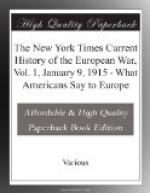To us in England this war is a life or death struggle between two principles—Pan-Germanism on the one side, with its avowed purpose to impose its hegemony and its rigid system of ideas and organization on the rest of the world, not by consent, but by irresistible military force; on the other side the claim of the other nations, large and small, to maintain inviolate their freedom and individuality, and to think and work out for themselves their own political and economic future in their own way.
The one principle would seem the flat contradiction of all that America stands for, the other principle would seem to be precisely the essential idea of free self-government and democratic evolution, in which are rooted the very life and being of America.
For this reason there is instinctive and profound sympathy on the part of the great majority of native Americans with the cause of England and her allies.
This sympathy is not merely the tie of blood or the unity of ideals. Reason has convinced Americans that the supreme principles and highest interests of America will be best safeguarded if the Allies win.
They dread instinctively what might happen if Pan-Germanism absorbed the smaller nationalities, crushed the great free countries like France and England, and dominated the whole world with the “mailed fist,” not only Europe and the Far East, but South America and the Pacific. Perhaps the hint of Count Bernstorff that Canada may be treated like Belgium, and the Monroe Doctrine like other “scraps of paper,” may also have thrown some light for Americans on a “Germanized” future! And a cast-iron system of commercial and industrial monopoly dictated by German needs cannot attract.
America Can’t Stand Apart.
That is one side that American statesmen have to consider. There is, of course, another.
The United States visibly form the greatest force the world has yet seen to bring together, to unite, to assimilate, in the development of their vast territories, measureless resources, and complicated industries, all that is best from all the other great nations, welding slowly but surely, through free institutions, these new elements into instruments for the fuller realization of the generous and noble ideals for which America stands. Perhaps an eighteenth or even fifteenth part of the population is of German origin, a percentage not far from equal to that contributed by the United Kingdom and Canada.
There is thus not only the broad question of avoiding war with Germany, whose people have so large a share in the life of America, a war doubly unwelcome at all times because of the innumerable links of science, invention, professional training, of commerce, and of personal friendship; but there is also the local question of peace and good-will in the daily work of America as between huge sections of her population. These visible facts not unnaturally give great weight to the argument for neutrality. No wise man on this side of the Atlantic will try to ignore them, or take exception to the dignity and correctness with which the American Executive has dealt with the grave problem before it.




